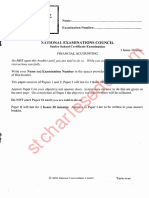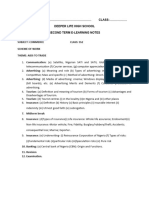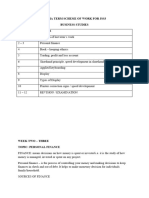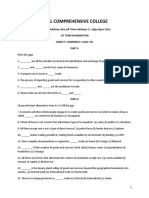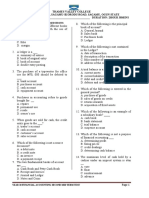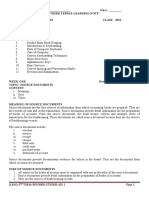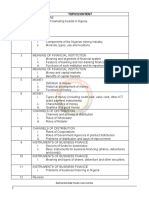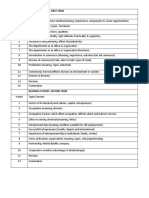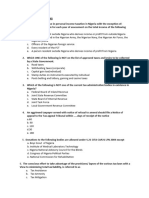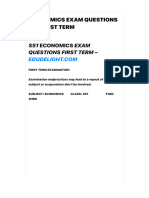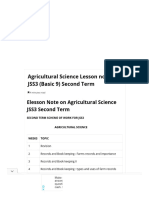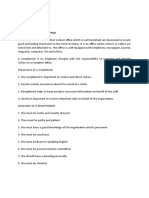2ND Term S1 Commerce
2ND Term S1 Commerce
Uploaded by
Judith NgeneCopyright:
Available Formats
2ND Term S1 Commerce
2ND Term S1 Commerce
Uploaded by
Judith NgeneOriginal Description:
Original Title
Copyright
Available Formats
Share this document
Did you find this document useful?
Is this content inappropriate?
Copyright:
Available Formats
2ND Term S1 Commerce
2ND Term S1 Commerce
Uploaded by
Judith NgeneCopyright:
Available Formats
Name: ________________________________________________________ Class: ____________________
SECOND TERM E-LEARNING NOTE
SUBJECT: COMMERCE CLASS: SS1
SCHEME OF WORK
WEEK TOPIC
1 Foreign Trade – Introduction
2. Balance of Trade, Term of Trade, Balance of Payments etc
3. Foreign Trade – Structure and Procedures
4 Foreign Trade – Stages and Documentation
5 Customs and Exercise Authority
6 Terms of Quoting Prices /Methods of Payment in Foreign Trade
7 Ports Authority
8-9 Transportation
10 Water Transportation
WEEK ONE DATE ………………
TOPIC: FOREIGN TRADE
CONTENT
1) Reasons for foreign trade
2) Advantages and disadvantages of foreign trade
3) Barriers to foreign trade
4) Classification of foreign trade
NOTES
Foreign trade or international trade or external trade is the exchange of goods and services
between two or more countries e.g. Nigeria, Japan and USA
Reasons for International Trade
1) Uneven distribution of natural resources
2) Differences in climatic conditions
3) Differences in skills and technical know-how i.e. technological difference
4) Differences in the cost of production
5) To augment domestic production of goods and services
6) The need to expand existing market for products
7) The differences in quantity and quality of labour force
8) The need to establish relationship with other countries
IMPORTANCE (ADVANTAGES) OF FOREIGN TRADE
1) It increase government revenue through taxes such as import duties, export duties etc.
2) It improves the standard of living of participating countries by making available
products that cannot be produced by a country
3) It encourages international specialization and its resultant increase in total output
4) It fosters friendly relationship among nations
5) It is a source of foreign exchange earnings
6) It promotes the transfer of technology
7) It creates employment opportunities in participating countries
8) It widens the world market
9) It enhances the promotion of economic development
DISAVDANTAGES OF FOREIGN TRADE
MR OSHO/2ND TERM/COMMERCE/SS 1 Page 1
Name: ________________________________________________________ Class: ____________________
1) It may lead to the destruction of cultural and moral values of a country
2) Excessive specialization may lead to over-production of goods in a country
3) It encourages dumping of goods
4) It may lead to structural unemployment
5) It leads to over-dependence of countries on each other
6) It creates balance of payments problems
7) It creates distortions in the economy e.g. neglect of the agricultural sector in Nigeria
8) It leads to the importation of harmful goods.2
EVALUATION
1. What five benefits does Nigeria derive from engaging in foreign trade
2. State seven differences and three similarities between foreign trade and internal trade
PROBLEMS OR DIFFICULTIES ENCOUNTERED IN FOREIGN TRADE (OR
BARRIERS TO FOREIGN TRADE)
1) Problem of distance, transportation costs etc.
2) Currency differences and exchange rate risks
3) Differences in weights and measures
4) Language barrier and communication problems
5) Cultural and religious barriers
6) Political and diplomatic barriers
7) Artificial barriers/regulations e.g. tariffs, quota, embargo, licenses and other economic
barriers
8) Documentation and administrative procedures are too many and more complicated
9) Differences in technical specifications
CLASSIFICATIONS OF FOREIGN TRADE
1. Import, Export and Entrepot
a. Import refers to goods bought from other countries
b. Export refers to goods sold to other countries
c. Entrepot refer to buying from one country in order to resell to another
2. Bilateral and Multilateral Trade
a. Bilateral Trade is a trade agreement in which two countries exchange goods
and services as trading partners
b. Multilateral Trade: This refers to a situation where a country has more than
one trading partner at the same time.
2. Visible Trade and Invisible Trade
a. Visible trade refers to the trade in items of tangible goods – goods that can be
seen, touched and felt.
b. Invisible trade refer to the trade in items that cannot be seen, felt or touched.
They are usually services e.g. banking transport, insurance, tourism,
aviation/air services, shipping services, consultancy services etc.
EVALUATION
1. State and explain five problems likely to be face by a businessman who wants to sell
his goods overseas
2. Distinguish between the following tems:
A. Bilateral Trade and Multilateral Trade
B. Visible Trade and Invisible Trade
READING ASSIGNMENT
Essential Commerce for SSS by O.A. Longe Page 44 – 53
Comprehensive Commerce for SSS by J.U. Anyaele Page 117 – 137
MR OSHO/2ND TERM/COMMERCE/SS 1 Page 2
Name: ________________________________________________________ Class: ____________________
GENERAL EVALUATION QUESTIONS
1. What is a bonded warehouse
2. State five importance of warehousing to Commerce
3. What factors should be considered in siting a small retail shop
4. What five benefits does Nigeria derive from engaging in international
trade
5. State and explain five problems likely to be faced by a businessman
who wants to sell his goods overseas
WEEKEND ASSIGNMENT
1. Re-exporting imported goods to another country is known as ____ trade
A. Barter B. visible C. invisible D. entrepot
2. International trade transactions are conducted on the principle of A. utmost good
faith B. equity C. collateral labour agreement D. comparative cost advantage
3. Bilateral trade is the trade _____ A. Among various countries B. Between two
countries C. Among commonwealth countries D. Among ECOWAS member states
4. When producers in one country sell off their excess produce at a very low price the
practice is described as A. Hedging B. entrepot trading C. Dumping D.counter trading
5. One of the barriers to foreign trade is the presence of
A. Difference in goods and services B. Dfferent means of transportation
C. Many security personnel D. Tariffs on goods and services
THEORY
1. What is foreign trade?
2. State four disadvantages of foreign trade.
WEEK TWO DATE …………..
TOPIC: FOREIGN TRADE
CONTENTS
1. Terms of trade: Balance of Trade: Balance of Payments
2. Tools of trade restriction 3. Measures for promoting exports
Terms of trade: Balance of Trade: Balance of Payments
A. Terms of Trade: This is the relationship between the prices of a country’s exports and
prices of her imports.
1. Favourable Terms of Trade: This occurs when a country’s export have higher
prices than the prices of her imports.
2. Unfavourable Terms of Trade: This is the situation when a country’s exports have
lower prices than the prices of her imports.
Terms of Trade = Price index of Exports x 100
Price Index of Imports
B. Balance of Trade: This shows the relationship between the total value of a country’s
visible exports (i.e. her receipts from visible exports) and that of her visible imports
(i.e. her payments for visible imports) during a given period of time, usually one year.
Balance of trade can be favourable when exports exceeds imports or unfavourable
when imports is greater than exports.
C. A balance of payments is an annual statement of all payments made to other countries
and total receipts from those countries. It is a comprehensive statement of income and
expenditure on international account for one financial year.
The balance of payment is made up of three main accounts:
(i) Current Account
MR OSHO/2ND TERM/COMMERCE/SS 1 Page 3
Name: ________________________________________________________ Class: ____________________
(ii) Capital Account
(iii) Monetary Movement Account
FREE TRADE: Free trade means non – restriction of foreign trade. It is a situation where
buying and selling takes place between different countries without restrictions or impositions
of artificial barriers e.g. tariffs.
TOOLS OF TRADE RESTRICTION
(MEASURES OF RESTRICT IMPORTS or MEASURES USED TO CONSERVE
FOREIGN EXCHANGE)
1. Tariffs or imports duties
2. Devaluation of the domestic currency i.e. lowering the value of a country’s currency with
respect to others. If this is done, imports becomes costly while exports will be cheaper
3. Embargo – i.e. prohibition or outright ban placed on some imported goods
4. Import / Export Quotas – imposition of limits on the quantity of goods that can be
imported or exported.
5. Foreign Exchange Control – Imports can be discouraged by making it difficult to obtain
foreign exchange to pay for foreign goods. This is done by strictly controlling the
availability of foreign exchange required for foreign trade transactions.
6. Import License: This is a permit that allows goods to be imported. It is used to limit the
persons who can import certain goods and the quantities those people can import.
TARIFFS
Tariffs are taxes imposed on imported goods either as a percentage of their value (Ad
Valorem Duty) or on the amount or quantity (i.e. units) of goods imported (Specific Duty).
The idea of tariffs is to reduce the amount of trade. Tariff is also referred to as import duty.
PURPOSES FOR WHICH TARIFFS ARE IMPOSED or (REASONS FOR
IMPOSITIONOF TARIFFS or WHY COUNTRIES IMPOSE RESTRICTIONS ON
FOREIGN TRADE)
1. To protect infant industries
2. To raise revenue for the government
3. To prevent dumping of goods from foreign countries
4. To correct balance of payments deficits
5. To influence or control consumption patterns in the economy
6. As a retaliatory measure
7. To prevent importation of dangerous goods e.g. cigarettes, alcohols
8. To encourage local production of goods thereby generating employment opportunities
9. For political motives. Tariffs can be introduced as discriminatory measure against
unfriendly countries
10. To protect and preserve cultural natural heritage e.g. wildlife, artifacts
EVALUATION
1. Define the following A. Tariffs B. Dumping
2. State five advantages of free trade
UNFAVOURABLE BALANCE OF PAYMENTS
An unfavourable balance of payments means that a country’s expenditure (payments) on
visible and invisible imports is greater than her income (or receipts) from visible and invisible
exports. It can be referred to as adverse balance or deficit balance.
CORRECTING AN ADVERSE BALANCE OF PAYMENTS
MR OSHO/2ND TERM/COMMERCE/SS 1 Page 4
Name: ________________________________________________________ Class: ____________________
An unfavourable or deficit balance of payments may be corrected by the following measures:
1. Imposition of tariffs – this will reduce importation of goods
2. Devaluation of the domestic currency i.e. Naira
3. Exchange control regulations i.e. control of foreign exchange transactions
4. Increasing exports by establishment and promotion of import – substitution industries
5. Borrowing from international financial institutions e.g. I.M.F.
6. Sale of foreign investments and assets
7. Increase in domestic production of goods
MEASURES FOR PROMOTING EXPORTS
The government of a country can promote exports through the following methods:
1. Giving subsides to export related industries to reduce their cost of production
2. By the reduction of export duties
3. Establishment of export promotion agencies like Export Credit Guarantee Scheme,
Commodities Boards etc
4. Devaluation of the domestic currency – this will make exports cheaper
5. By giving tax incentives to export related industries
6. Creation of Export Processing Free Zones - EPFZ are industrial areas provided with
adequate infrastructures to produce mainly for export
7. Provision of credit facilities to exporters
8. Promotion of exports through trade fairs and exhibitions of home – made goods in foreign
countries
9. The government can simplify export procedures and documentation
10. Reduction in freight rate
EVALUATION
1. Explain the meaning of the term “favourable balance of payments”
2. Explain five methods that can be used to correct an adverse balance of payments
READING ASSIGNMENT
Essential Commerce for SSS by O.A. Longe Page 44 – 53
Comprehensive Commerce for SSS by J.U. Anyaele Page 117 – 137
GENERAL EVALUATION QUESTIONS
1 List five features of a multiple shop
2 Give any five reasons why small scale retailing is common in Nigeria
3 State any five channels of distribution for consumer goods
4 Explain five factors to be considered before choosing a particular channel of
distribution
5 Outline five services rendered by the wholesaler to the manufacturer
WEEKEND ASSIGNMENT
1. The rate at which a country’s goods is exchanged for that of another country is called A.
balance of trade B. balance of payments C. foreign exchange D. terms of trade.
2. The difference between a country’s visible and invisible exports and its visible and
invisible imports in a given period is A. balance of payments B. balance of trade C. term
of trade D. foreign exchange rate
3. Which of the following is not an aim of imposing customs tariffs A. to raise revenue B. to
promote home C. as an anti-dumping measure D. to discourage foreign investors
4. Which of the following is not a method of trade restriction A. exchange control B. import
license C. entreport D. quota
MR OSHO/2ND TERM/COMMERCE/SS 1 Page 5
Name: ________________________________________________________ Class: ____________________
5. One way of restricting the quantity of goods which may be imported into a country is by
A. dumping B. balance of payment s C. quotas D. terms of trade
THEORY
1. State four measures used to restrict imports.
2. State three reasons for the imposition of tariff.
WEEK THREE DATE …………
TOPIC: FOREIGN TRADE
DOCUMENTS USED IN INTERNATIONAL TRADE
1. Indent: This is an order by an importer to an agent requesting the agent to buy goods on
behalf of the importer. There are two types:
a) Open Indent: This is an order which gives the agent freedom to buy goods from any
firm or manufacturer he considers suitable
b) Closed Indent: In this order, the importer specifies the firm or manufacturer from
whom the agent should buy the goods required.
2. Bill of Lading: This is a document of title giving the holder a right to take possession of
the goods to which it refers. It is the document of contract between the exporter and the
shipping company (ship owner) for the carriage of goods to their destination. It is made
out in triplicates.
The bill of lading contains the following information:
a) The name of the ship carrying the goods (consignment)
b) The shippers name – i.e. the name of the person sending the goods. In other words the
consignor’s name.
c) Full description of the goods i.e. quantity, type, etc.
d) The names of the ports of embarkation (i.e. the port from which the ship is taking off
and disembarkation (i.e. the port to which the ship is taking the goods)
e) The rate of freight
f)The name of the consignee i.e. the person receiving the goods
g) The date of shipment e.t.c.
A bill of lading could be either:
1. A clean bill of lading: This is a bill of lading signed without any qualification clause i.e.
without any words to the effect that the goods are damaged. It is taken as proof that the
goods were in good condition when loaded.
2. A dirty bill of lading (or foul bill of lading): Where a bill of lading bears qualifying
clauses such as “two sack broken” or “one case damaged”, the bill of lading is referred to
as a foul bill or dirty bill.
A dirty bill of lading is therefore a bill of lading which bears an endorsement by the
master of a ship to the effect that the goods are defective.
EVALUATION
1. List five information contained in a bill of lading.
2. State two uses of indent in international trade.
IMPORTANCE (FUNCTIONS OR PURPOSE) OF THE BILL OF LADING
a) It is a contract between the exporter and the shipping company. It is therefore an evidence
of the contract to carry the goods.
b) It is a document of title that shows the owner or buyer of the goods. It therefore gives
power to the owner or consignee to obtain delivery of the goods.
MR OSHO/2ND TERM/COMMERCE/SS 1 Page 6
Name: ________________________________________________________ Class: ____________________
c) It serves as a receipt for the goods and thus establishes that the goods are on board the
ship
d) It is a document of evidence that the goods has been shipped
e) It is a negotiable instrument. It is transferable only by endorsement and can therefore be
used as security for loans.
3. Consular Invoice: This is an invoice that has been signed by the consul of the country to
which the goods is to be consigned. The invoice is signed to prevent understating the price so
as to pay less customs duty.
A consular invoice is therefore a special invoice which customs authorities request from the
importer to enable them to know the appropriate duties chargeable. The invoice will ensure
correct payment of duties by showing the correct price of the goods. It is a special form of
invoice legalized by a consul in an importing country.
PURPOSE OF CONSULAR INVOICE
a) To prevent understatement of prices
b) To ensure correct payment of customs duties
EVALUATION
1. List three documents used in foreign trade
2. Explain the use of the consular invoice in international trade.
READING ASSIGNMENT
Essential Commerce for SSS by O.A. Longe Page 53 – 64
GENERAL EVALUATION QUESTIONS
1 Give five examples of small scale retail outlets
2 Explain five reasons for the survival of small scale retailers
3 State five aids to trade and explain how each facilitates trade
4 Explain any five reasons why commerce is important in the life of a nation
5 Illustrate with a labeled diagram the main divisions and subdivisions of production
WEEKEND ASSIGNMENT
1. Direct exchange of goods for goods between two countries is known as A. counter trade
B. entrepot trade C. barter trade D. multilateral trade
2. In international trade, which of the following performs the same functions as the
consignment note A. export license B. insurance certificate C. bill of lading D. certificate
of origin
3. The use of sealed large metal boxes for transporting goods is known as A. packaging B.
standardization C. containerization D. bulk carrying
4. A document completed by a ship’s captain which gives full details of goods carried on his
ship for a particular voyage is known as A. bill of lading B. consignment C. ship manifest
D. waybill
5. Which of the following is used only in international trade A. Bill of Exchange B.
Purchase Order C. Bill of lading D. Pro – formal Invoice
WEEK FOUR DATE ……………
TOPIC: FOREIGN TRADE
DOCUMENTS USED IN INTERNATIONAL TRADE
4. Certificate of Origin: This is a document signed by the customs officer of the exporting
country to show the country from which the goods have been exported or where it originated
MR OSHO/2ND TERM/COMMERCE/SS 1 Page 7
Name: ________________________________________________________ Class: ____________________
from. This document is important when the importing country has a preferential tariff
applicable only to certain countries e.g. ECOWAS member states.
Uses of the Certificate of Origin
a. It shows where the goods come from
b. It serves as an instrument for preferential tariff
c. It helps to determine outflow of foreign exchange to the country of origin
5. Bill of Sight: This is a temporary document which enables goods to be examined by
customs officials before the arrival of shipping documents.
A bill of sight is submitted to the customs authorities if a full description of the imported
goods cannot be provided e.g. due to the non – arrival of shipping documents (i.e. bill of
lading). It enables the goods to be landed and their inspection is done while a full description
of the goods will be provided later.
6. Bill of entry: This is a document that contains detailed particulars (information) of all
imported goods coming into the country. It provides the customs with particulars of goods
imported.
7. Export/Import Licence: This is an authority to import or export given by the Ministry of
Industry to an individual or company. It gives access to the importer to purchase foreign
exchange for this purpose.
EVALUATION
1. State three importance of the Certificate of Origin in International Trade.
2. Write short notes on the following: A. Bill of Sight B. Bill of Entry
8. Letter of Hypothecation: This is a letter an exporter send together with the shipping
document empowering a bank to sell the goods in the foreign country for the best price
available if the importer fails to accept (or pay) the bill or pay for the goods.
9. Documentary Credit: This is a bill of exchange to which various shipping documents like
bill of lading, export invoice and insurance policy are attached.
NB: The underlisted documents which are also in used in foreign trade have been mentioned
in connection with other topics already taught.
10. Ship’s Manifest
11. Charter Party
12. Export Invoice
13. Freight Note
14. Airway Bill/Consignment Note
15. Dock Warrant
16. Certificate of Insurance or Insurance Policy
17. Shipping Note
EVALUATION
1. Write short notes on the following showing their main uses in foreign trade A.
Shipping Note B. Shipping Manifest C. Bill of Sight D. Dock Warrant (e) Bill of
entry
2. Explain the three types of Charter Party.
READING ASSIGNMENT
MR OSHO/2ND TERM/COMMERCE/SS 1 Page 8
Name: ________________________________________________________ Class: ____________________
Essential Commerce for SSS by O.A. Longe Page 53 – 64
GENERAL EVALUATION QUESTIONS
1 Give five reasons why small scale retail businesses may fail
2 List five instances where a manufacturer may decide to sell his goods directly to the
consumer
3 State eight features of hawking
4 Explain five reasons why tariffs are imposed on imports
5 Explain five features of itinerant trading
WEEKEND ASSIGNMENT
1. A contract of carriage is same as A. charter party B. consignment note C. delivery note D.
ships manifest
2. In international trade, _______ is used to show the exact country where the goods are
imported A. bill of lading B. consular invoice C. shipping note D. certificate of origin
3. A “dirty bill” is used to indicate whether the goods arriving a port are ______ A. being
awaited B. on transit C. damaged D. delivered
4. A contract for the hire of ship is known as A. charter party B. ship brokers C. shipper’s
council D. shipping conference
5. A receipt given by a warehouse keeper for goods lodged in the warehouse is called A.
consular invoice B. dividend warrant C. dock warrant D. pro forma invoice
THEORY
1. List four documents used in Foreign Trade
2. What is an Airway Bill
WEEK FIVE DATE …………….
TOPIC: FOREIGN TRADE
CONTENT
1) Functions of the Nigerian Customs and Excise Authority
2) Methods of calculating customs duties
3) Customs and Excise Drawback
FUNCTIONS OF THE NIGERIAN CUSTOMS AND EXCISE AUTHORITY
1) Supervision of bonded warehouse.
2) Prevention of smuggling.
3) Collection of customs duties (i.e. import duties and export duties) and excise duties.
4) Enforcement of ban on prohibited goods.
5) Supervision of import and export trade.
6) Collection of data and provision of statistics on international trade.
7) Prosecution of smugglers.
8) Provision of quarantine facilities for animals/plants.
9) Issuance of licenses for the manufacture and sale of certain goods in the country.
10) Exchange currency control/checking of illegal trafficking of currency notes.
EVALUATION
1. What functions are performed by the Nigerian Customs Authority?
2. Explain the difference between customs duties and excise duties.
CUSTOM DUTIES OR TARIFFS
Customs duties, also tariffs, are taxes imposed mainly on imports and exports.
MR OSHO/2ND TERM/COMMERCE/SS 1 Page 9
Name: ________________________________________________________ Class: ____________________
METHODS OF CALCULATING CUSTOM DUTIES
There are two methods of calculating customs duties, namely, specific duty and ad valorem
duty:
a. Specific Duty or Tax: Here the amount of the tax to be paid depends on the amount or
quantity of goods bought so that the greater the quantity of goods bought, the greater the
tax to be paid
b. Ad Valorem Duty or Tax: The amount of the tax to be paid depends on the value or
quantity of the commodity. This value or quality is measured in terms of the price of the
commodity. This means that goods which have higher prices are supposed to have higher
values and are therefore taxed more heavily than goods whose values/prices are lower.
CUSTOMS AND EXCISE DRAWBACK
Where goods on which import duty has already been paid are re-exported a refund of the duty
may be claimed. This refund is called a customs drawback.
Excise duties are taxes on goods produced and consumed within a country. Where goods on
which excise duty has been paid are now to be exported, a refund called excised drawback
may be claimed by the exporter of such goods.
EVALUATION
1. Explain the differences between Specific duty and Ad Valorem duty.
2. Distinguish between customs drawback and excise drawback.
READING ASSIGNMENT
Comprehensive Commerce for SSS by J.U. Anyaele Page 44 – 64
GENERAL EVALUATION QUESTIONS
1 State five features of a supermarket
2 State the difference between industry and commerce
3 Mention and explain five types of commercial occupations
4 State five functions performed by the customs authority
5 Explain five factors that adversely affect the growth of commerce in West Africa
WEEKEND ASSIGNMENT
1. If a country wishes to discourage imports, it A. removes quotas B. encourage free trade C.
imposes tariffs D. subsidizes exports
2. A tax paid on goods manufactured and consumed in your country is called A. goods tax
B. customs duty C. excise duty D. consumer tax
3. The relationship between a country’s visible imports and exports in a trading year is
known as A. balance of payment B. balance of trade C. terms of trade D. international
trade
4. Bonded warehouse is controlled and supervised by A. customs B. navy C. immigration D.
quarantine
5. Which of the following is an invisible trade item A. crude oil B. cocoa C. groundnut D.
shipping
THEORY
1. Give three functions of the Customs and Excise Authority
2. State two ways of Calculating Customs Duties
WEEK SIX DATE …………
TOPIC: FOREIGN TRADE
MR OSHO/2ND TERM/COMMERCE/SS 1 Page 10
Name: ________________________________________________________ Class: ____________________
CONTENT
1. Terms of quoting prices in international trade
2. Methods of payment in foreign trade
TERMS OF QUOTING PRICES IN INTERNATIONAL TRADE
1. Cost, Insurance and Freight (CIF): The price quoted includes cost of the goods, insurance
and freight up to the port of destination while the purchaser is responsible for all
subsequent charges.
2. Free Alongside Ship (FAS): The price quoted covers all expenses till the goods arrive at
the side of the ship.
3. Free on Board (FOB): The price quoted covers all expenses (costs) up to loading of goods
on ship at the port of departure.
4. Free on Rail (FOR): The price quoted covers all costs up to loading of goods on the
railway at the terminus of departure.
5. Cost and Freight (C&F): The price quoted includes the cost of the goods and freight
charges from country of export to the importing country but not insurance.
6. Franco (Rendu or Free): The price quoted includes all types of expenses until delivery to
importer’s warehouse.
7. Loco (Spot or Ex-Warehouse or Ex-Works): This is the price quoted when quotation is
immediate and goods are sold just where they are – that is the warehouse of the exporter
and the buyer must bear all the cost of removing the goods.
EVALUATION QUESTIONS
1. Explain five terms of quoting price in foreign trade.
2. Write short notes on the following terms of price quotation.
A. Franco B. Loco C. Free on Board
METHODS OF PAYMENT IN FOREIGN TRADE
The importer could pay the exporter through one of the following methods of payment, all of
which use the banks as intermediaries.
1. Mail Transfer: This is an order to pay sent by a letter or air mail by a bank to its branch or
agent in a foreign country to pay a specified sum of money to a named beneficiary.
2. Telegraphic Transfer (Cable Transfer) or Telex Transfer: Here the payment order is sent
by a bank via telegraph, cable or telex to another bank in another country to pay a
specified sum of money to a named beneficiary.
3. Foreign Bill of Exchange: This is a bill drawn by the exporter and sent to the importer
who is expected to accept it and send it back to the exporter. The exporter can then
discount the bill with a financial institution.
4. Traveller’s Cheques: This is an order or instruction upon a bank to pay a stated sum of
money in foreign currency. Travelers (and businessmen) to other countries can use the
travelers cheque to settle their bills.
5. Banker’s Draft (Bank Draft): Here, the importer asks his banks to draw a foreign draft in
favour of the exporter he wishes to buy goods from.
6. Letter of Credit: A letter of credit is a letter addressed by a banker to its correspondent or
agent bank requesting it to advance a sum of money to the holder and to debit the sum so
paid to the account of the banker issuing the letter of credit.
A letter of credit could either be:
a. Confirmed and Irrevocable letter of credit
b. Unconfirmed and Revocable letter of credit.
Most payments in foreign trade are made by means of confirmed and irrevocable letter of
credit.
MR OSHO/2ND TERM/COMMERCE/SS 1 Page 11
Name: ________________________________________________________ Class: ____________________
EVALUATION QUESTIONS
1. List and explain four means of payment in foreign trade.
2. Explain three ways by which commercial banks facilitate foreign trade.
READING ASSIGNMENT
Essential Commerce for SSS by O.A. Longe Page 53 – 64
GENERAL EVALUATION QUESTIONS
1 Give five reasons why manufacturers pre – package their products
2 State any four disadvantages of pre – packaging
3 State six distinguishing features of a mail order business
4 Give four advantages of mail order business
5 State six contents of a bill of lading
WEEKEND ASSIGNMENT
1. A bank’s undertaking to pay an exporter on behalf of an importer is a A. documentary
credit B. letter of credit C. letter of hypothecation D. bill of lading
2. Which of the following documents gives banks the right to sell goods and recoup all
administrative expenses. If the importer fails to pay for the goods ordered A. letter of
hypothecation B. confirmed letter of credit C. revocable letter of credit D. cover note
3. Which of the following is most acceptable to an exporter for payment A. personal
certified cheques B. standing order C. confirmed letter of credit D. bill of exchange
4. A document which can be used for both internal and external trade is A. bill of exchange
B. IOU C. Promissory Note D. GIRO
5. Which of the following is regarded as a document of title in foreign trade A. Consular
Invoice B. Bill of Lading C. Bill of sight D. Certificate of Origin
THEORY
1. List four means of payment in foreign trade.
2. Write short notes on the use of Telegraphic transfer as a means of payment in foreign
trade.
WEEK SEVEN DATE:………………………
TOPIC: PORT ADMINISTRATION, FACILITIES & AGENCIES
CONTENT
1) Facilities provided by a good sea port
2) Facilities provided by an airport
3) Functions of the Nigerian Ports Authority
4) Problems confronting Ports Authorities
SOLUTION TO WEEKEND ASSIGNMENT OBJECTIVE
1) B 3) C 5) A
2) D 4) A
THEORY
1) Transportation by pipeline is the method of transporting liquids and gases through pipes
laid underground or on surface of the land
2) A common carrier is a person or form who undertakes as a regular business to transport
goods from one place to another for anyone willing to pay the freight charges in west
Africa/ Nigeria
3) Function of the Federal Airport Authority of Nigeria
MR OSHO/2ND TERM/COMMERCE/SS 1 Page 12
Name: ________________________________________________________ Class: ____________________
CONTENT
A. Facilities provided by a good sea Port
1. Dredging 2. Lighting 3. Buoying 4. Transit sheds 5. Warehouses 6. Berth 7. Boats 8.
Cranes 9. Office facilities 10. Conveyor belts 11. Forklifts 12. Quays 13. Wharf 14.
Pipelines 15. Roads 16. Railway lines 17. Re - fuelling facilities 18. Hospitals/First Aid
clinics 19. Emergency Disaster control 20.Mechanized berths
B. Facilities provided by an airport
(1) Runways (2) Control Tower (3) Hangars (4) Parking spaces (5) Arrival/departure
longues/halls
(6) Warehouses (7) Re – fuelling facilities (8) Hospitals/first and clinics (9) Office facilities
C. Functions of the Nigerian Ports Authority
I. Provision of facilities, such as dredging, lighting, buoying, transit sheds as well as storage
and warehousing accommodation.
II. Cargo handling
III. Collection of revenue at the ports
IV. Provision of security services
V. Provision of sanitation services
VI. Dredging of the channel of the ports
VII. Provision of office accommodation for the customs, immigration, law enforcement
agencies
VIII. Maintenance of all facilities in all seaports in the country
D. PROBLEMS THAT CONFRONT PORT AUTHORITIES IN WEST
AFRICA/NIGERIA
1. Congestion of ports thereby delaying berthing of ships and discharging of cargoes
2. Smuggling – this reduces the revenue that would have accrued to the Authority
3. Corruption among its officials
4. Inadequate warehousing facilities
5. Shortage of qualified personnel for the handling of goods, facilities etc
6. Prevalence of obsolete (out dated) equipment
7. Pilfering is rampant- due to dishonesty on the part of some of the ports personnel and
activities of ‘port rats’
8. Careless handling of goods resulting in damages
9. Delays in clearing of goods by importers
10. Political interference/government bureaucracy etc
11. Unstable government policies e.g. on destination inspection
12. High cost of demurrage being paid by importers due to ports management inefficiency
EVALUATION
1. Explain the function of the N.P.A
2. What problems are encountered by the N.P.A. in course of performing these function
FUNCTIONS OF THE FEDERAL AIRPORT AUTHORITY OF NIGERIA (FAAN)
1. Provision of facilities like landing, fuelling facilities in all airports in Nigeria
2. Collection of airport changes and taxes
3. Maintenance of all facilities in all airports in the country
4. Operation of the control tower
5. Environmental sanitation of the airports
6. Provision of security services at the airports
7. Provision of warehouses, office accommodation parking spaces etc
8. Promotion of tourism
MR OSHO/2ND TERM/COMMERCE/SS 1 Page 13
Name: ________________________________________________________ Class: ____________________
REVIEW QUESTIONS
1. List four facilities provided by a good seaport.
2. Explain five functions of the Federal Airport Authority of Nigeria.
GENERAL EVALUATION QUESTIONS
1 State five functions performed by a wholesaler in the channel of distribution
2 Explain five factors that encourage the elimination of middlemen from the channel
of distribution
3 Give five reasons why retail shops adopt self service
4 Explain six facilities that a retail shop should have to encourage self service
5 Explain five measures taken by a country to restrict imports
WEEKEND ASSIGNMENT
1. The institution responsible for the maintenance of facilities in the wharf is A. customs
department B. Ministry of Trade C. Ministry of Transport D. Nigerian Ports Authority
2. A contract of carriage is same as A. ships manifest B. advice note C. charter party D.
delivery note
3. Which of the following means of transport is most flexible A. air B. rail C. sea D. road
4. Which of the following is used for moving only goods from one seaport to another A.
ferry B. ocean liners C. cargo liners D. coastal liners
5. Charges paid by a ship for staying at a port beyond tune is called A. freight B. dead
Freight C. Demurrage D. Dispatch Money
THEORY
1. List four facilities provided by an Airport
2. Mention two problems encountered by the Nigerian Railway Corporation in course of
performing its functions.
WEEK 8 DATE……………….
TOPIC: TRANSPORTAION
CONTENT
i. Definition
ii. Importance of transportation to commerce
iii. Commercial requirements of a good transport system
iv. Factors influencing the choice of type of transportation
v. Methods of transportation
NOTES
Transportation is the process of conveying goods and people from one place to another either
through water, road, rail or air.
Importance of transportation to commerce and industry.
1. It facilitates quick and efficient distribution of goods and services
2. it encourages large scale production by widening the market for goods and
services
3. it improves the people’s standard of living by facilitating their movement and
making needed goods available
4. Transportation prevents wastage of perishable goods
5. it enhances specialization and division of labour
6. it provides employment opportunities and sources of income to operators in the
sector
MR OSHO/2ND TERM/COMMERCE/SS 1 Page 14
Name: ________________________________________________________ Class: ____________________
7. it facilitates international trade
8. It leads to speedy economic growth and development.
COMMERCIAL REQUIREMENTS OF A GOOD TRANSPORT SYSTEM
1. Low cost/ reasonable cost
2. Safety of passengers and good
3. Convenience
a. Flexibility: i.e easy to adopt to existing situations
b. Minimum formalities: The procedures involved in its operations must not be
complicated
c. Timing of operations must not be too rigid
4. Speed: especially for urgently needed or perishable goods
5. Reliability: enabling traders to get their goods on schedule
EVALUATION QUESTIONS
1. How does transportation make modern commerce possible
2. List seven requirements of a good transportation system.
FACTORS TO BE CONSIDERED IN SELECTING THE RIGHT TYPE OF
TRANSPORT FOR THE DELIVERY OF GOODS
1. The distance involved
2. The nature of the goods i.e. perishable, fragile, durable or timed goods
3. The value of the goods
4. The cost of transport/the freight charges
5. The quantity of goods to be conveyed
6. The urgency of delivery
7. The needs and wishes of the consumers/owners of the goods
8. The reputation of the carrier
9. The position or situation of goods involved
10. The customs of the trade or the firm
11. The weight or bulkiness of the goods
12. The type of transportation available in the areas
13. The destination of the goods
The various methods of transport available for conveying persons or goods from one place to
another are:
1. Porte rage
2. Air
3. Beast or burden
4. Pipelines
5. Road
6. Containerization
7. Rail
8. Water.
EVALUATION QUESTIONS
1. List six means of transportation of goods in Nigeria.
2. Describe five factors that determines the choices of means of transportation for
goods
GENERAL EVALUATION QUESTIONS
1 Explain five measures taken by a country to promote exports
2 State the difference between an ordinary invoice an a pro forma invoice
3 Explain five roles of transportation to businessmen
4 List and explain five problems associated with international trade
MR OSHO/2ND TERM/COMMERCE/SS 1 Page 15
Name: ________________________________________________________ Class: ____________________
5 Give four advantages and three disadvantages of A. branding B. self service C.
vending machine
WEEKEND ASSIGNMENT
1. The aid to trade responsible for the preservation of perishable items is A. warehousing
B. insurance C. transportation D. advertising
2. The oldest means of transporting goods is by A. porter B. lorry C. train D. canoe
3. In the selection of means of transport, speed is an important consideration for goods
that are A. bulky B. durable C. fragile D. perishable
4. Road transport is the commonest means of transport because it is the A. fasters B.
cheapest C. most flexible D. most comfortable.
5. Which of the following is NOT a means of transportation A. rail B. pipelines C.
radio
THEORY
1. In which THREE ways does transportation aid commerce
2. Give TWO commercial requirements of a good transport system.
READING ASSIGNMENT
Comprehensive Commerce SSS page 100-114
Essential Commerce for SSS page 214-228
WEEK NINE DATE:
…………………….
TOPIC: FORMS OF TRANSPORTATION
CONTENT
Advantages and disadvantages of :
1. Road Transportation 4. Transportation by pipelines
2. Rail transportation 5. Containerization
3. Air transportation 6. Water transportation
NOTES
There are four major forms of transportation namely: land, air, pipeline and water. Land
transportation can abe divided into road and rail transport while containerization can be
adapted to suit the other methods of transportation.
Road Transportation: The various means of transportation by road are buses, lorries,
trailers, tankers, bicycles, tricycles, other motor vehicle, camels, donkeys etc. it is the most
extensively used of all the means of transportation.
Advantages of Road transportation
1. It is very cheap-cost of transportation is low
2. It is flexible – it has no fixed time schedule
3. It offers door to door delivery of goods
4. It is faster on a short journey
5. Packaging procedures - i.e loading and unloading is not complicated
6. It does not require special routes like trains
7. It is available in a variety of vehicles.
Disadvantages of Road Transport
1. it is more prone to accidents compared to rail or air transport
2. Slow for long journeys
3. It does not operate on schedule
MR OSHO/2ND TERM/COMMERCE/SS 1 Page 16
Name: ________________________________________________________ Class: ____________________
4 .It is not suitable for carrying fragile goods
5. Welfare facilities such as toilet, canteen, television etc, are not usually provided
6. It has limited capacity for carrying heavy and bulky goods
2. Rail transportation: This consists of passengers trains and good train of various types.
Advantages of Rail Transportation
1. larger capacity for bulky goods/passenger
2. Standard rate of charges
3. less prone to accidents compared with road transport
4. It operates on schedule
5. Welfare services e.g. bath, toilets, canteen are provided
Disadvantages of Rail Transportation.
1. high capacity and maintenance costs
2. it is not flexible as it observes rigid time table in its movement
3. Slow for short distance journeys
4. The routes are fixed making it unsuitable for door to door
3. Air transportation: The various means of transportation by air includes planes,
hovercrafts, helicopters, jets, rockets etc.
Advantages of Air Transportation
1. It is the fastest means of transportation
2. It is comfortable, luxurious and efficient
3. it is suitable for long distances
4. it is reliable as it moves on schedule
5. It has multi-purpose usage.
Disadvantages of Air Transportation
1. The cost of air fare is very expensive
2. High capital expenditure and operating system
3. It is vulnerable to limited by weather condition
4. It is unsuitable for heavy and bulky goods
5. Accidents are usually fatal.
EVALUATION QUESTIONS
1. State five reasons why road transport would be preferred to rail transport
2. Explain five problems of using rail transport in Nigeria
4. Transportation by Pipelines: Pipelines are means of transporting gases and liquid
through pipes laid underground or on the land surface.
Advantages of Transportation by pipelines
1. it occupies little space
2. It has low running cost/maintenance costs
3. Can be constructed in any type of terrain e.g. land, swamp, air, or under the sea
4. It makes possible continuous flow of goods within obstructions
5. It is relatively safe
Disadvantages of Transportation by Pipelines
1. Non flexibility –pipelines, once laid cannot change their course
2. It is not suitable for all types of goods
3. Heavy capital expenditure
4. prone to leakages, unauthorized tapping which may be undetected for a long time.
MR OSHO/2ND TERM/COMMERCE/SS 1 Page 17
Name: ________________________________________________________ Class: ____________________
5. Containerization: This refers to the packaging of goods into large rectangular containers
of uniform size and weight.
Advantages of Containerization
1. it facilitates easy handling of goods
2. it reduces incidence of pilfering
3. It protects the goods against the elements of weather
4. it is adaptable for transportation in ships, lorries, trains or air planes
Disadvantages of Containerization
It reduces employment opportunities available for dock workers as containers are usually
loaded into ship by cranes or special fork-lifts.
6. Water Transportation: this is the form of conveying goods and people from one place
to another through the rivers, lakes, seas or oceans by ships, boats, canoes, ferry etc.
Advantages of Water Transportation
1. suitable for heavy and bulky goods
2. It is very safe
3. It is relatively cheaper
4. It may be adapted to carry perishable goods e.g. refrigeration
5. it operates on schedule
6. It is comfortable and has luxurious facilities
Disadvantages of Water Transportation
1. High capital expenditure requirement
2. It is very low
3. It is limited by weather condition
4. High maintenance costs
5. it is not flexible – as it moves on schedule
EVALUATION QUESTIONS
1. State five advantages of transportations by pipe lines.
2. List five disadvantages of water transportation.
GENERAL EVALUATION QUESTIONS
1 Explain five ways by which foreign trade is different from home trade
2 Identify five advantages and four disadvantages of automatic vending
3 Explain six functions of wholesalers to manufacturers
4 List and explain six methods used in correcting an adverse balance of payments
5 State six facilities a good seaport should have
WEEKEND ASSIGNMENT
1. Which of the following is not a factor to be considered in selecting a means of
transport
2. Sea transport is unsuitable for the movement of A. antiquities B. coal C.
fertilizers D. vegetables
3. Gases are best transported by A. air B. canal C. pipelines (d0 rail
4. The mode of transport that conveys goods at low cost per unit is A. road B. rail
C. air D. pipelines
5. Which of the following is not an advantage of water transport over all
transportation A. speed B. flexibility C. cost D. capacity.
THEORY
1. What is transport by rail
MR OSHO/2ND TERM/COMMERCE/SS 1 Page 18
Name: ________________________________________________________ Class: ____________________
2. State three reasons why rail transport would be preferred to road transport
READING ASSIGNMENT
Comprehensive Commerce SSS page 100-114
Essential Commerce for SSS page 214-228
WEEK TEN DATE:………………………
TOPIC: WATER TRANSPORTATION
CONTENT
1) Types of water transportation
2) Terminologies connected with water transportation
TYPES OF WATER TRANSPORTATION
A. Inland Water Transport: This type of water transport operates within a nations boarders.
Goods and people are moved from one place to another through the rivers, canals, creeks
and lakes e.g. River Niger and River Benue. Boats, canoes, ferries and launches are used
in inland water transport.
B. Sea Transport (International Water Transport): This involves the movement of good
(cargoes) and people from one country to another on the seas and oceans. The vessels
employed in this regard include ocean liners, coastal liners, tramp liners, tankers and
container ships. Sea transport is very important in international trade.
MEANS OF TRANSPORTATION BY SEA
1. OCEAN LINERS: These are ships that sail through the high seas and oceans of the
world at schedule times and on set routes. They charge standard fixed freights and are
bigger and faster than tramp liners. Ocean liners are sub-divided into:
a. Passenger liners: These are passengers carrying ships following fixed routes. They
have to move at fixed times and therefore sail whether they have full complement
(number) of passengers or not. They are luxurious and very comfortable.
b. Cargo liners: These are ships which carry heavy and bulky goods from one place
to another on the high seas and oceans. Cargo liners operates on a specific time
table and they normally run on definite routes. They can also carry few
passengers.
2. Coastal Liners: These are flat – bottom streamers that are used to convey goods along
the coast to the main port. They can go through the creeks and rivers easily. Coastal
liners are mostly used to carry raw materials and primary products to and fro the main
port where the cargo liners are docked. They are sometimes called LIGHTERS OR
TUGS.
3. Tankers and Supertankers: These are specially designed ships used in carrying crude
oil, refined petroleum products and sometimes liquefied gas.
4. Tramp liners: These have no fixed routes nor fixed time-tables. They carry cargoes
where they are found and leave when they have loaded sufficient cargoes. They are
available for general hire. i.e. they are most often chartered by traders for a given
period or a particular voyage. They operate as SEA-TAXIS. Their charges are not
fixed i.e. charges can be bargained.
Differences between Tramp Liners and Ocean Liners
S/N Tramp Liners Ocean Liners
1. They have no specific route They operate on specific route
2. They have no fixed timetable They operate on specific timetable
3. They have no fixed rate of charges They charge standard rates of freight
4. They may not be luxurious Passenger liners are luxurious
MR OSHO/2ND TERM/COMMERCE/SS 1 Page 19
Name: ________________________________________________________ Class: ____________________
5. They handle only cargoes They handle both cargo and passengers
6. They are available for general hire They are booked in advance
7. They are relatively smaller in size They are relatively bigger in size
SHIPPING CONFERENCES
A shipping conference is an association of all the shipping companies serving any particular
route formed with the objective of protecting members interest and to better serve the shipper
(i.e. one who sends goods by ship)
FUNCTIONS OF SHIPPING CONFERENCES
1. To maintain freight rates at a particular margin
2. To ensure that a sufficient minimum of cargo is always available for regular services
3. To provide regular sailings and the assurance of definite delivery dates to shippers
4. To ensure a measure of security for shipping operations.
EVALUATION
1. State five differences between a tramp liner and an ocean liner
2. List four features of cargo liners.
SPECIAL TERMS CONNECTED WITH TRANSPORTATION
A. CHARTER PARTY
A charter party is a contract (agreement) by which a merchant hires (leases) a ship or an
aircraft for the carriage of goods or passengers either for a particular voyage (journey) or
during a specified period, for a sum of money called freight.
Types of Charter Party
1. Voyage Charter: In this type of contract the charterer (i.e. the one hiring the ship) hires
the ship for his use during a particular voyage.
2. Time Charter: Here, the charterer has the ship at his disposal for a determined period of
time e.g. Six months – during which any number of voyages (journeys) can be made.
Note: In both voyage and time charter possession of the ship remains in the hands of the
owner of the ship and navigation is carried on by the owner’s servants (i.e. captain and
crew).
3. Charter by Demise: The charterers of the ship makes all the arrangements for navigation
of the ship. The charterer has a complete control over the ship and crew and may order
the ship to go to any port or to carry any cargo.
B. COMMON CARRIERS AND PRIVATE CARRIERS
A common carrier is a person or firm who undertakes as a regular business to transport goods
from one place to another for any one wiling to pay a reasonable charge.
A person who carries passengers as part of his business (e.g. taxi-driver) and anyone who
makes special contracts with each of his customers (e.g. a furniture mover) is not a common
carrier.
A private carrier is one who reserves the right to choose his customers, or who undertakes to
carry goods only as a casual operation.
TERMINOLOGIES USED IN THE TRANSPORT INDUSTRY
1. Dead Freight: This is the freight paid on unoccupied space in the ship. If there is empty
space left in the ship, the person that charter must pay for the space used.
2. Manifest: A document which shows full list of the cargo carried by a ship or aircraft.
3. Lay days: The specific period or days allocated to a ship to complete its loading and
unloading at the docks or habour.
MR OSHO/2ND TERM/COMMERCE/SS 1 Page 20
Name: ________________________________________________________ Class: ____________________
4. Demurrage: The extra charge or penalty paid for failing to off-load a ship within a
stipulated time. It is paid by the charterer.
5. Dispatch money: Payment by the ship owner to the charterer for lay days not used by the
charterer.
6. Lump Sum Freight: This is the amount agreed to be paid by a charterer irrespective of the
quantity of goods actually shipped and whether or not he loads a full cargo.
EVALUATION
1. Define the term charter party
2. Mention and explain the three forms of charter party
GENERAL EVALUATION QUESTIONS
1 Explain five advantages of large scale retailing
2 Explain the following: A. counter trade B. invisible trade C. entrepot trade
3 State five barriers to international trade
4 List and explain six factors that will determine a seller’s mode of transportation
5 State seven advantages of international trade
WEEKEND ASSIGNMENT
1. Ships that pick up cargo from any port and travels anytime are called A. Cargo ships B.
tramps C. tankers D. ferries
2. Crude Oil is best transported within the country through A. a container B. a trawler C. a
tanker D. pipeline
3. A contract for the hire of a ship is known as A. Hire purchase B. shipper’s council C.
charter party D. shipping conference
4. An importer would prefer see transport if his order is A. bulky and durable B. perishable
C. urgently needed D. to be delivered at his warehouse.
5. The main advantage of sea transport over air transport is A. capacity B. safety C. speed D.
patronage
THEORY
1. What is transportation by pipeline?
2. Who is a common carrier?
READING ASSIGNMENT
1. Essential Commerce for SSS by O.A. Longe Page 100-110
2. Comprehensive Commerce for SSS by J.U Anyaele Page 214 – 228
MR OSHO/2ND TERM/COMMERCE/SS 1 Page 21
You might also like
- 1ST Term SS1 CommerceDocument52 pages1ST Term SS1 Commercepraisechibiko1925100% (1)
- Commerce SS1 Third Term Lesson PlanDocument14 pagesCommerce SS1 Third Term Lesson PlanIvan ObaroNo ratings yet
- Business Studies Jss 1Document5 pagesBusiness Studies Jss 1Moses Ahmed100% (2)
- Free Financial Accounting NECO Past Questions DownloadDocument9 pagesFree Financial Accounting NECO Past Questions DownloadCharles Obaleagbon100% (1)
- Lesson Note On Business StudiesDocument4 pagesLesson Note On Business StudiesOmagbemi William0% (1)
- Foreign Trade University: VocabularyDocument32 pagesForeign Trade University: VocabularyVũ Như NgọcNo ratings yet
- Commerce SS2Document17 pagesCommerce SS2adesuwaNo ratings yet
- 1st Term s1 Financial AccountDocument21 pages1st Term s1 Financial AccountAsabia OmoniyiNo ratings yet
- SS 3 Economics First Term NoteDocument28 pagesSS 3 Economics First Term NoteimemunetuNo ratings yet
- 7487 - SS2 First Term - 01 - Manufacturing AccountDocument6 pages7487 - SS2 First Term - 01 - Manufacturing AccountDon SimauluNo ratings yet
- Current Jss 2 Business Studies 2nd TermDocument24 pagesCurrent Jss 2 Business Studies 2nd Termpalmer okiemuteNo ratings yet
- 3RD Term SS1 Economics Note For StudentsDocument25 pages3RD Term SS1 Economics Note For Studentsinyamahchinonso100% (1)
- Third Term ss3 Financial AccountingDocument38 pagesThird Term ss3 Financial AccountingJanet HarryNo ratings yet
- 2ND Term SS2 CommerceDocument63 pages2ND Term SS2 Commercepalmer okiemuteNo ratings yet
- 1st Term .Sss2 Financial AccountDocument23 pages1st Term .Sss2 Financial Accountsamuel joshuaNo ratings yet
- Business Studies JSS3Document9 pagesBusiness Studies JSS3onasanyaolu0916No ratings yet
- SS2 WEEK 4 - National Income Accounting - Ending 03-06-2022 3rd Term.Document11 pagesSS2 WEEK 4 - National Income Accounting - Ending 03-06-2022 3rd Term.lenee letambariNo ratings yet
- Commerce SS2Document51 pagesCommerce SS2Thomas EmmanuelNo ratings yet
- 1ST Term J1 Business StudiesDocument15 pages1ST Term J1 Business StudiesPeter Omovigho DugboNo ratings yet
- JS1 1ST Term Business StudiesDocument28 pagesJS1 1ST Term Business Studiespalmer okiemuteNo ratings yet
- Ss2 Scheme of WorksDocument5 pagesSs2 Scheme of WorksMicheal HaastrupNo ratings yet
- Commerce Ss1 1st TermDocument3 pagesCommerce Ss1 1st TermEngr Olu AkeusholaNo ratings yet
- 3RD Term SS2 Economics Note For StudentsDocument36 pages3RD Term SS2 Economics Note For Studentsinyamahchinonso100% (1)
- First Term Ss2 Marketing 1Document3 pagesFirst Term Ss2 Marketing 1hopeg0539No ratings yet
- FINANCIAL ACCOUNT YEAR 10 2nd Term TERM TESTDocument4 pagesFINANCIAL ACCOUNT YEAR 10 2nd Term TERM TESTJanet HarryNo ratings yet
- 1st Term Jss1 Business Studies b7Document13 pages1st Term Jss1 Business Studies b7palmer okiemute100% (1)
- Internal Trade Testing - 1 (Direct Questions)Document9 pagesInternal Trade Testing - 1 (Direct Questions)Saahil LedwaniNo ratings yet
- Types of Ledgers: 1. Sales Ledger or Debtors' LedgerDocument2 pagesTypes of Ledgers: 1. Sales Ledger or Debtors' LedgerBilal SiddiqueNo ratings yet
- BUSINESS STUDIES Jss 1Document22 pagesBUSINESS STUDIES Jss 1lordsenoxNo ratings yet
- ECO102 Topic 3 Lecture Notes PDFDocument14 pagesECO102 Topic 3 Lecture Notes PDFThemba MdlaloseNo ratings yet
- 1ST Term J1 Business StudiesDocument14 pages1ST Term J1 Business StudiesAsabia OmoniyiNo ratings yet
- Business Studies Exam Questions For JSS1 Third TermDocument14 pagesBusiness Studies Exam Questions For JSS1 Third TerminestimablelordNo ratings yet
- SS1 EconomicsDocument56 pagesSS1 EconomicstimothyNo ratings yet
- Home TradeDocument24 pagesHome Tradeanga100% (3)
- Business Studies - Office Procedure - JS3Document23 pagesBusiness Studies - Office Procedure - JS3GODWINNo ratings yet
- Commerce Exam Questions For SS1 Third TermDocument15 pagesCommerce Exam Questions For SS1 Third TerminestimablelordNo ratings yet
- 3RD Term J1 Business StudiesDocument18 pages3RD Term J1 Business StudiesDada Rasheed100% (1)
- PSAF 2019 Pilot Solution Set 2Document17 pagesPSAF 2019 Pilot Solution Set 2divaamy4No ratings yet
- Business Studies For Jss3Document13 pagesBusiness Studies For Jss3onasanyaolu0916No ratings yet
- SS 2 Fin. Accounting First Term ExamDocument10 pagesSS 2 Fin. Accounting First Term ExamMadu Cecilia chiomaNo ratings yet
- SSS3 First Term Economics e 1Document56 pagesSSS3 First Term Economics e 1Dayo OpesanmiNo ratings yet
- Principles and Practices of Marketing Notes (VVP)Document58 pagesPrinciples and Practices of Marketing Notes (VVP)Ferdy (Ferdy)No ratings yet
- Economics SS1 Third Term Lesson PlanDocument11 pagesEconomics SS1 Third Term Lesson PlanIvan Obaro0% (1)
- Business Studies JSS1Document1 pageBusiness Studies JSS1Timothy0% (1)
- Commerce WaecDocument6 pagesCommerce WaecolaNo ratings yet
- 1st Term j2 Business StudiesDocument32 pages1st Term j2 Business StudiesDaniel AsunomehNo ratings yet
- NECO Accounting Questions and Answers 20232024 (Essay and Objectives) - Bekeking 9Document1 pageNECO Accounting Questions and Answers 20232024 (Essay and Objectives) - Bekeking 9ibrahimyerima41No ratings yet
- Jss 1 Business Studies-First TermDocument12 pagesJss 1 Business Studies-First TermQuincyNo ratings yet
- Exam Likeable Questions On Income Tax in NigeriaDocument16 pagesExam Likeable Questions On Income Tax in Nigeriaalphatrade500No ratings yet
- Economics Exam Questions Ss1 First TermDocument9 pagesEconomics Exam Questions Ss1 First Termadekanmid4No ratings yet
- Agricultural Science Lesson Note For JSS3 (Basic 9) Second TermDocument8 pagesAgricultural Science Lesson Note For JSS3 (Basic 9) Second TermNurain KhalilullahNo ratings yet
- BBA AccountingDocument2 pagesBBA AccountingAnonymous UKybnj9Otd50% (2)
- JSS1 Basic Technology 3rd Term Lesson Note PDFDocument48 pagesJSS1 Basic Technology 3rd Term Lesson Note PDFojo ayodeji johnsonNo ratings yet
- 1st Term s1 Financial AccountDocument22 pages1st Term s1 Financial Accountonasanyaolu0916No ratings yet
- Business Studies JSS 2Document16 pagesBusiness Studies JSS 2EBIWONJUMI KOLAWOLE AMOSNo ratings yet
- Second Term JSS3 Business StudiesDocument23 pagesSecond Term JSS3 Business Studiesolayoonuabdulqawiyy22No ratings yet
- JS1 3RD Term Business StudiesDocument28 pagesJS1 3RD Term Business Studiespalmer okiemuteNo ratings yet
- SS1 Economics Third Term Note2022Document56 pagesSS1 Economics Third Term Note2022Emmanuel EyoNo ratings yet
- 1ST Term J3 Business StudiesDocument19 pages1ST Term J3 Business Studiesoluwaseun francisNo ratings yet
- Civic Education Jss 2 Second TermDocument8 pagesCivic Education Jss 2 Second TermAndrewNo ratings yet



